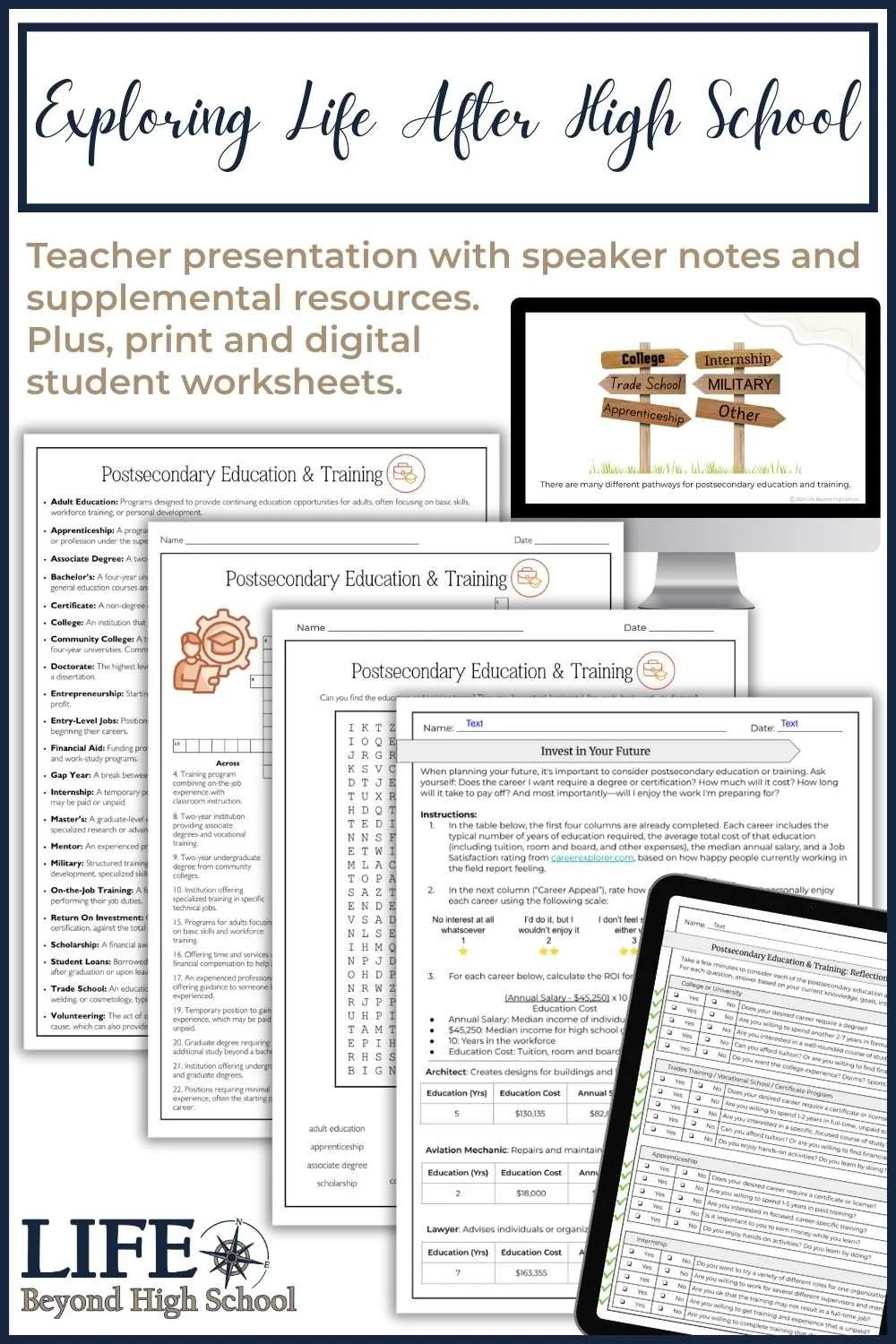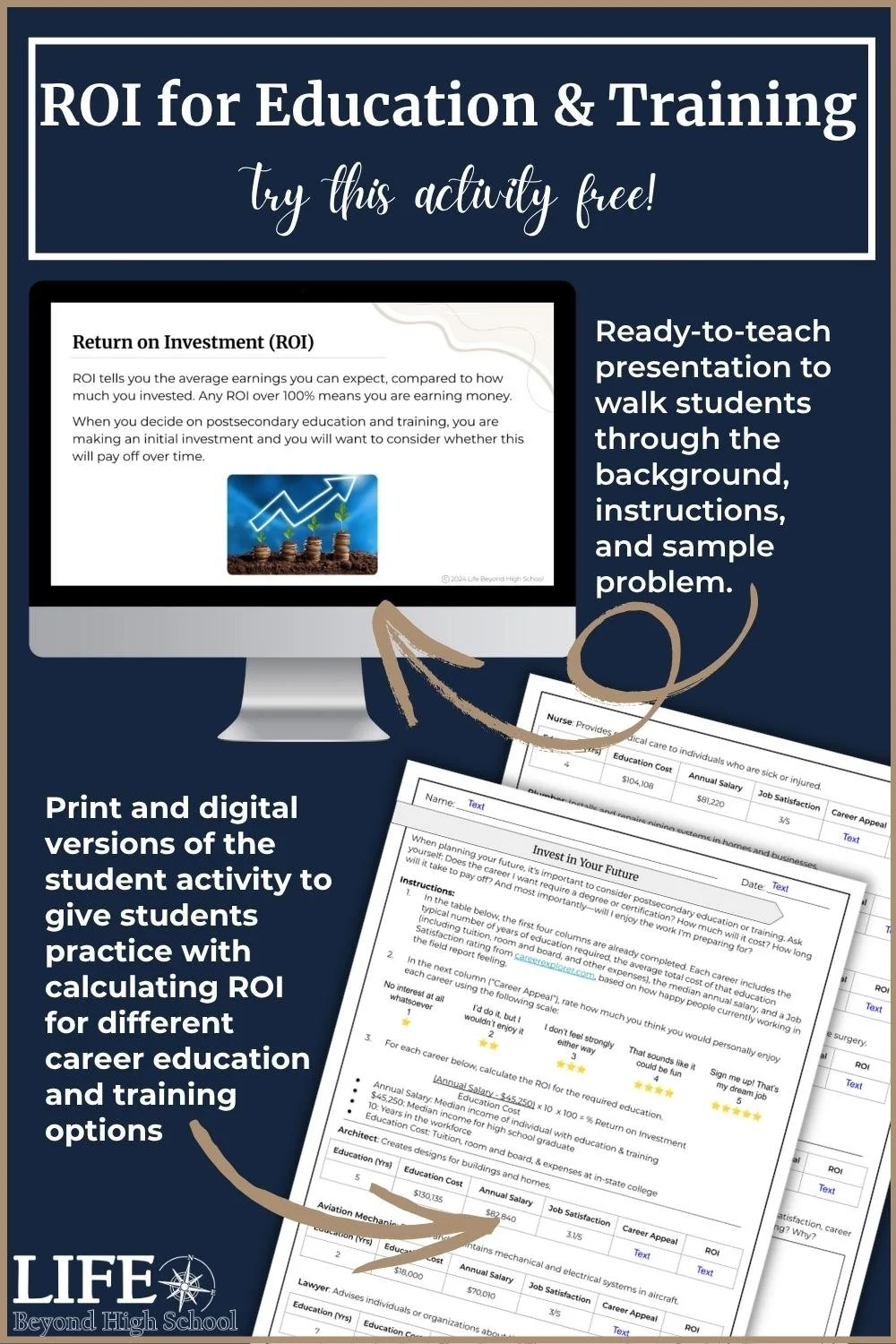Exploring Postsecondary Education & Training Options
Help your students answer the big question: “What’s the plan after graduation?”
For many high school students, this question can feel overwhelming. College may be the first thing they hear about, but it’s far from the only option. This ready-to-use lesson helps students explore multiple postsecondary pathways, reflect on their goals, and make informed, realistic plans for their future.
What’s Inside the Lesson
Part of the Education & Training collection from Life Beyond High School, this lesson helps students explore real-world postsecondary options. It is designed to save you time and keep students engaged with clear, teacher-friendly materials:
Interactive Google Slides Presentation
Walk students through six postsecondary options with built-in speaker notes, linked videos, and reflection questions.Pathway Overviews for Every Student
College & University – Understand degrees, majors, public vs. private colleges, and certificate programs.
Trade Schools – Compare hands-on training programs with traditional college routes.
Apprenticeships – Learn how to “earn while you learn” in real-world career training.
Internships – Discover how internships support career prep and skill-building.
Military Education Programs – Explore educational opportunities and benefits available through military service.
Alternative Routes – Consider gap years, travel, volunteering, or starting a business.
Hands-On Activities
Reflection Activity – Students evaluate six postsecondary options, decide what fits their interests, and consider next steps.
ROI for Education – A practical, real-world activity where students calculate the cost and value of different training paths. Want to test it out first? Try the ROI activity for free.
Postsecondary Vocabulary Puzzles – Word search, crossword, and definition sheet to reinforce key terms. Already included in this lesson—or grab the puzzle set separately here.
Exit Ticket – A simple wrap-up to help students identify their next step toward the future.
Why Teachers Love This Lesson
❤️ Time-Saving – No prep required. Just open, teach, and engage.
❤️ Student-Friendly – Reflection questions and peer discussions make abstract ideas tangible.
❤️ Flexible – Perfect for advisory, career prep, or general education classes.
❤️ Future-Ready Focus – Helps students connect today’s choices to tomorrow’s opportunities.
What Other Teachers Are Saying
⭐⭐⭐⭐⭐ “This was just what I was looking for to use with my class for a unit on college and career. It engaged the students.”
Related Resources
To build a complete transition planning toolkit, pair this lesson with:
Career Exploration Scavenger Hunt – A hands-on activity to help students research careers.
ROI for Education Freebie – A free activity included in this lesson that you can download separately.
High School Transition Activities Bundle – Combine this lesson with self-advocacy, goal-setting, and other key transition resources.
College Transition Lesson – Help students navigate campus resources and request accommodations.
Your Top Postsecondary Planning Questions, Answered
1. How do you teach postsecondary planning in high school?
Exposure is key. Many students only consider the pathways they’ve seen in their own families or communities. This lesson gives students a clear look at multiple options (college, trade school, apprenticeships, internships, the military, and alternative routes) so they can understand the full range of possibilities and make informed decisions.
2. What’s included in the Exploring Postsecondary Education & Training Options lesson?
This resource is packed with ready-to-use materials to save you time:
Lesson plan and interactive presentation with teacher notes and supplemental video links
Six pathway overviews
Built-in think-pair-share questions
Student reflection sheet
ROI for Education activity
Postsecondary vocabulary puzzles (word search, crossword, definition sheet)
Exit ticket
3. Is this resource appropriate for special education students or struggling learners?
Yes! The lesson is designed with accessibility in mind, using visuals, teacher-led instruction, and peer discussions, rather than relying solely on text-heavy materials. However, it’s best for students preparing for independent education or employment after high school. For students in supported programs (e.g., with job coaches), it may be too advanced.
4. Can I use this lesson in advisory, career prep, or general education classes?
Absolutely. This lesson works in any setting where students are preparing for an independent future, whether that’s college, career, or military service.
5. Does the lesson include any free activities?
Yes! You can try the ROI for Education activity for free. It’s one of the main activities from the full lesson and gives students hands-on practice comparing the real costs and benefits of different education and training options.
6. How does this lesson fit into a larger transition planning curriculum?
Education and career planning go hand-in-hand. Many teachers start with this lesson (and related career exploration activities) before moving on to independent living skills. Once students know their career goals and the training they’ll need, they’re better prepared to plan realistic budgets and living arrangements.
7. Can students complete this lesson independently, or is it teacher-led?
This lesson is primarily teacher-led. You’ll guide students through the presentation, then they’ll work independently or with a partner on reflection activities, ROI calculations, and vocabulary puzzles.
💡 Pro Tip: Pair this lesson with the Career Exploration Scavenger Hunt for a natural follow-up or use it to supplement the High School Transition Activities Bundle for a complete planning sequence.
Want more ready-to-teach lessons like this one? Explore the full Education & Training collection for more postsecondary planning and college readiness activities.






